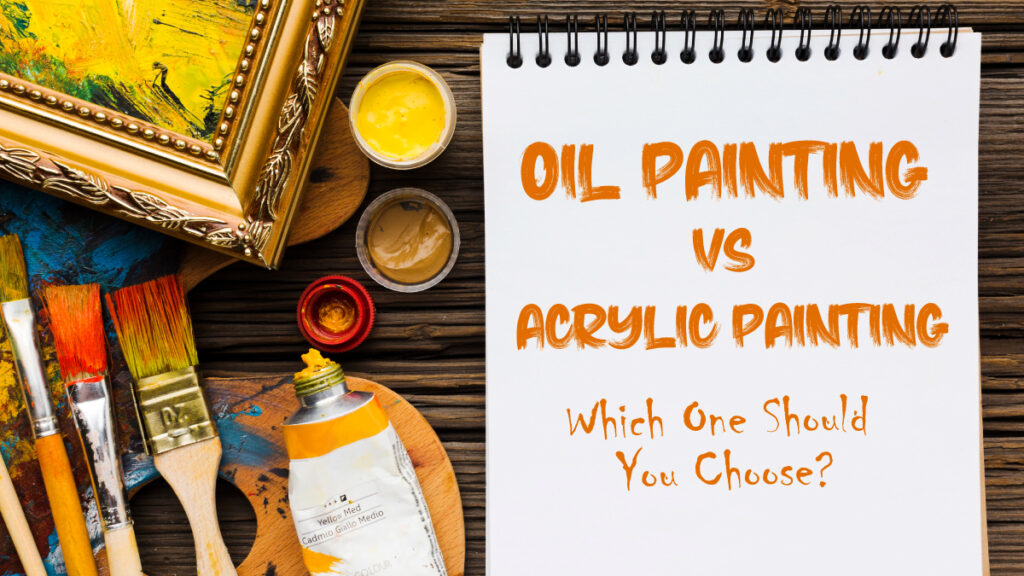Acrylic vs Oil Paint
One of the most varied ways that people have expressed themselves since the dawn of humanity is via art. There are countless ways to make art and even more ways to appreciate it. For instance, art and paintings are present in almost all cultures and societies. here we will discuss all about Acrylic vs Oil Paint in detail right below.
Here are the following topic going to discuss in this tutorial:
- Oil painting: what is it?
- Describe acrylic painting.
- Comparison Between Oil and Acrylic Paint?
- Pros and Cons of Acrylic Paint
- Pros and Cons of Oil Paint
- Conclusion
Although the technology and techniques used to create art have evolved over time, some forms of art and art materials have remained in demand. One of the earliest types of fine art, painting is broken down into subcategories based on the type of paint used.
Two of the most popular and well-known art styles, acrylic painting, and oil painting, will be covered in this article.
Oil versus acrylic painting
Paint has been used by artists for many centuries to create works of art on canvases and other surfaces. Oils and acrylics, two of the most popular kinds of paint, can result in comparable effects. But these two styles of painting differ significantly in important ways.

Oil painting: what is it?
For nearly as long as people have been creating paintings, oil painting has existed as a form of art. Many of the most well-known pieces of art in the world are oil paintings. Oil paints are one of the most acknowledged and well-liked color choices for artists because they have been around for millennia. Famous fine artists have also frequently used oils as a medium of choice, and they have a solid reputation.
The pigment is combined with a drying oil, such as linseed or walnut oil, to create oil paints. Oils prevent light from passing through, giving the paint a glossier appearance and feel. Oxidation and polymerization are how the drying oils dry. They create a film on top of the paint’s surface, acting as a barrier between layers of paint even when more paint is applied on top of it.
The superior tones and colors that oil-based paints can produce set them apart from other painting mediums. Additionally, when employed on canvas, oils can produce sharp effects as well as satisfactory linear treatment.
Describe acrylic painting.
Acrylic paint that has been thinned out with water is used in acrylic painting. It has the reputation for drying quickly and applying quickly, but the drawback of not being waterproof. Acrylic acid, which is also used to make Plexiglas and Lucite, is what acrylic paints are made of.
The most significant feature of acrylic paint is that it dries rapidly and can be applied to any surface without fear of leaving stains or damaging the finish thanks to its water-soluble nature. some people also like to use acrylic paint pen to make different kind of paintings as they are affordable and long lasting if taken proper care off.

Comparison Between Oil and Acrylic Paint?
Oil paint is formed from drying oils with a media of animal fat, linseed, or synthetic polymer. In contrast to acrylic paint, which is water-based, oil paint is made from drying oils with a medium of linseed.
Like watercolors, acrylics can be thinned and brushed. Students typically find acrylics to be simple to use and dry to a firm finish. Oils take longer to dry on the canvas, giving artists more time to mix colors or make adjustments.
Is Oil Painting Better Than Acrylic? What Benefits Do Acrylic Paints Have Over Oil Paints?
Many painters contend that acrylic paints are superior to oil paints or simpler to use, despite the ongoing controversy.
Because acrylic paint is water-based, cleaning brushes with chemicals is not necessary. Additionally more affordable than oils, acrylic paints enable painters to work more rapidly without having to worry about drying out their brushes or spending time on cleanup.
Additionally, because they dry considerably more quickly than oils, acrylics can be blended without worrying about the components separating.
Oil paint or acrylic paint: which lasts longer?
Water-based acrylics dry quickly but do not last as long as oils because of this. Oil paints take some time to dry, but if they are stored safely and away from light, they can survive for decades.
Which is simpler, oil or acrylic painting?
Understanding that every painting has unique qualities might end the discussion. People who prefer to work rapidly and wish to produce vibrant colors should use acrylics. People who wish to work slowly and meticulously should choose oil paintings.
Do Oil Paintings Cost More Than Acrylic Paintings?
It is possible for oil paintings to cost more to manufacture than acrylic paintings. The expense of purchasing paints itself is higher for painters. Water-based acrylic paints provide a glossy sheen and dry quickly. Acrylics are a fantastic option for painters on a budget because they are less expensive than oil paints.
The price or worth of an artwork, however, is rarely determined by the medium alone. No matter the medium, whether it be a painting, sculpture, shadow box, or any type of art, the worth of good art is determined by other factors. The sale price of the artwork will depend on a number of criteria, including talent, originality, uniqueness, notoriety, and others.
What happens if you paint over oil paint with acrylic?
Acrylic paint and oil paint are not interchangeable. These paints vary in thickness, color, and texture. This basically means that you will obtain a different outcome when you combine the two paints than if you had painted with only one of them.
Can I combine acrylic and oil paint?
No, you shouldn’t mix oil and acrylic paints since they are incompatible. Some brands of acrylic paint can be used to thin or dilute oil paintings, however, this is the exception rather than the rule. These two paints are difficult to combine, and when you do, the results are frequently subpar.
Appreciating Acrylic and Oil Paintings
Both acrylic and oil paintings can be purchased and amassed for a space’s décor or as an investment in fine art. Original oil or acrylic paintings made by modern artists are available for purchase at Eden’s online art gallery.
Pros and Cons of Acrylic Paint
Let’s discuss the pros and cons of Acrylic Paint
Pros
- Because acrylic paints are water-based, only water needs to be added to thin them (no toxic spirits are required). Additionally, brushes can be cleaned of wet paint with just soap and water.
- There is no need to wait for layers to dry in between painting sessions because typical acrylic paints dry quickly. Within a day or so, paintings are secure enough to ship.
- Traditional acrylics are permanently attached to the support after they are dry, unlike watercolors (another water-based paint). This facilitates painting additional layers on top of existing ones.
- It has been established that acrylic paints are more flexible than oil paints. Acrylics won’t break if you don’t go by the “fat over lean” criteria.
It is adaptable. Any surface that is devoid of oil and wax can be painted on. This comprises materials including plastic, metal, glass, cardboard, glass, canvas, wood, and paper. You can use acrylic paint on practically anything if you prepare it properly.
It soon dries. You can so complete your assignment more quickly. It dissolves in water. Without the use of paint thinners, you can wash it off your hands and brushes with soap and water while they are still damp. It is less harmful and safer for use around kids and animals.
It is less expensive. It is adaptable. Acrylics can be blended with a wide variety of other media to provide a variety of textures, sticking qualities, and drying times. It is robust. We’re aware that acrylics are flexible and won’t peel, break, or change shape.
People also tend to use it on bird houses to make them beautiful as its faster in drying and affordable without any harmful effects on birds in long run.
Disadvantages of Acrylic Paint
- When it dries, its color darkens, so the color you start with may not be the color you end up with.
- You must move rapidly since it dries quickly.
- Once dried, it is difficult to remove from brushes, nails, or clothing. The ideal strategy for keeping the brushes moist when painting so they are simple to clean is to keep a container of water close by. Additionally, you ought to dress protectively.
- Once dry, it is difficult to remove from clothing or nails.
- When compared to other paint mediums, it is viewed as “not as valuable” by some art galleries and collectors.
Like some oil paints, acrylic paints can include poisons in their pigments. Acrylics that use “retarder” to slow down the drying period may include additional poisons.
Because acrylic paints dry quickly, it is difficult to blend them together using the common “wet in wet” approach for oil paintings. Because of this, a finished acrylic painting may appear harsher than a finished oil painting.
After the paint dries, it cannot be altered or removed.
We’ve only used acrylic paints for 50 years, so we can’t really say how long they’ll last.
There will be a delay between drying times. Modern acrylic paint won’t dry as rapidly as you’d like it to.
Painting wet over dry acrylics may result in some color bleeding over time because the capacity to reactivate is eventually lost.
Even more recent than conventional acrylic paints are contemporary acrylic paints. Although efforts are being made to demonstrate their lifespan, nothing can be conclusively demonstrated until enough time has passed.
Pros and Cons of Oil Paint
Let’s discuss the Pros and Cons of Oil Paint:
Pros
- More time is available for working on your art.
Even after applying drying agents to the canvas, oil paints take a while to dry. When using this medium, you can put your pastime on hold for a few hours before returning to the painting. To continue working on it while the paint is still malleable, you may even wait until the next day.
- You can design believable transitions.
You have extra time to work on your color transitions because oil paints require more drying time. You can continue working on the delicate color shades, which gives you the chance to change or amend your ideas without having to start again with the creation.
- Your hues remain true to kind.
If you’ve ever used watercolors or acrylics, you’ve probably seen the color shift that occurs when they dry. Using oil paints avoids this problem. They adhere to the application exactly.
Cons
- It demands time commitment, for starters.
For oil paint, your canvas needs to be primed. To allow the artwork to dry, you must have patience. You must keep your paint in good condition. Oil paints require a lot more time to complete than other types of paint.
- It provides little in the way of contrast.
Oil paints need a number of days to dry in order to produce a sharp brush stroke. A handful of ours could be needed for acrylics.
- Oil paintings still undergo color fading with time.
With time, oil paintings tend to turn yellow. Even if the painting is sealed, this procedure cannot be avoided. The process can be slowed down but not stopped by using good binders.
Each pigment in oil paintings may need a different amount of time to dry, which presents a problem. They typically cost more as well. On the other hand, using this media makes it simpler to replicate your original artistic concept.
To assist you in determining whether oil painting is right for you, I will discuss what makes oil painting unique and what occasionally causes my eyes to briefly wander in the direction of another medium (don’t worry, oil, I’ll never leave!).
What advantages and disadvantages of using oil paint have you found in your painting?

Conclusion
Which of the acrylic and oil paints have you already tried using for a painting project? Which do you intend to utilize for the first time? Or, if you’ve used both when painting, which one do you think is simpler to use? Please share your thoughts with us; we look forward to hearing from you. Please feel free to remark, and we’ll be pleased to address any questions or concerns you may have.
Why not learn how to properly clean and take care of your brushes when oil painting now that you’ve explored the characteristics of oil and acrylic paint? How To Clean Oil Paint Brushes may be found here. Enjoy learning about the differences between acrylic and oil paint in the interim

Being associated with art and craft field since decades as a hobbyist and life long learner has given me an opportunity to learn many new things related to art, craft, paints and pottery which i am trying to share with your guys on this website. I have expertise of being professional painter and potter for the last 20+ years
I have learned mind blowing cool tips and insights which makes me a person with ability to improvise and come up with creative ideas and solutions to make stunning and impeccable art pieces of all types which are adored by people across the globe on this website and other platform.


